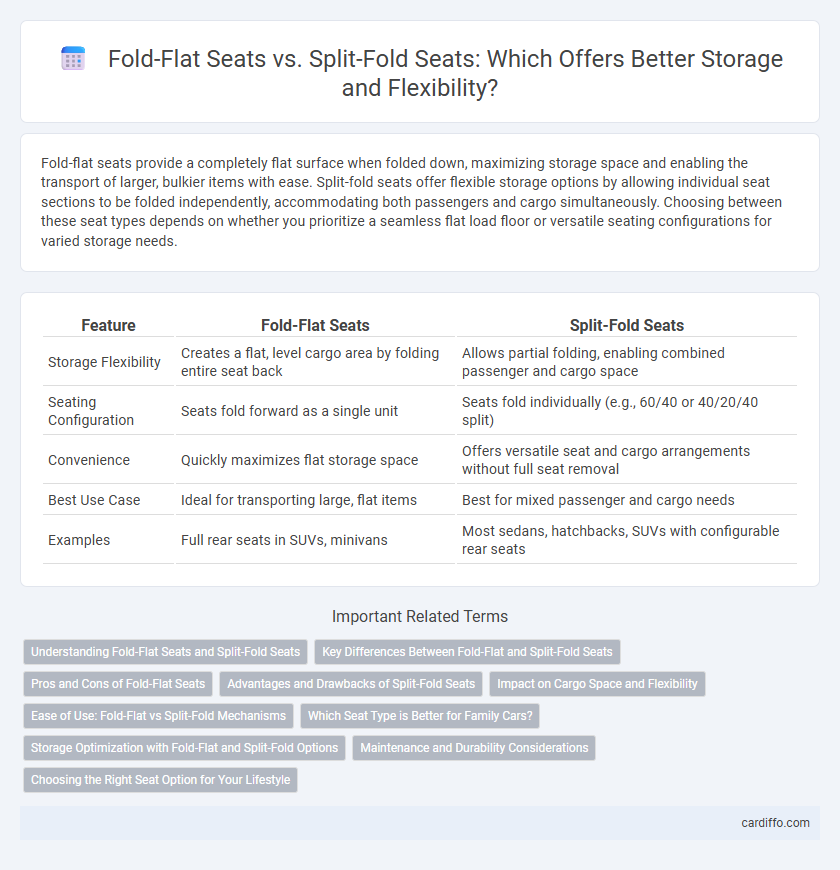Fold-flat seats provide a completely flat surface when folded down, maximizing storage space and enabling the transport of larger, bulkier items with ease. Split-fold seats offer flexible storage options by allowing individual seat sections to be folded independently, accommodating both passengers and cargo simultaneously. Choosing between these seat types depends on whether you prioritize a seamless flat load floor or versatile seating configurations for varied storage needs.
Table of Comparison
| Feature | Fold-Flat Seats | Split-Fold Seats |
|---|---|---|
| Storage Flexibility | Creates a flat, level cargo area by folding entire seat back | Allows partial folding, enabling combined passenger and cargo space |
| Seating Configuration | Seats fold forward as a single unit | Seats fold individually (e.g., 60/40 or 40/20/40 split) |
| Convenience | Quickly maximizes flat storage space | Offers versatile seat and cargo arrangements without full seat removal |
| Best Use Case | Ideal for transporting large, flat items | Best for mixed passenger and cargo needs |
| Examples | Full rear seats in SUVs, minivans | Most sedans, hatchbacks, SUVs with configurable rear seats |
Understanding Fold-Flat Seats and Split-Fold Seats
Fold-flat seats are designed to lay completely flat, creating a uniform, extended cargo area that maximizes storage space and allows for easy loading of large or bulky items. Split-fold seats feature independently adjustable sections, typically in a 60/40 or 40/20/40 split configuration, offering flexible storage options by folding down only a portion of the seat while keeping other sections upright for passengers. Understanding the distinctions between fold-flat and split-fold seats helps optimize vehicle interior space based on specific cargo and passenger needs.
Key Differences Between Fold-Flat and Split-Fold Seats
Fold-flat seats provide a completely flat cargo area by folding the rear seats entirely into the floor, maximizing storage space for large or bulky items. Split-fold seats divide the rear seating into sections, typically 60/40 or 40/20/40, allowing independent folding for flexible passenger and cargo configurations. The key difference lies in the balance between maximum flat storage surface offered by fold-flat seats and the adaptability and convenience of partial folding found in split-fold seats.
Pros and Cons of Fold-Flat Seats
Fold-flat seats offer maximum cargo space by creating a completely level surface, which simplifies loading bulky items and maximizes storage capacity. However, these seats can be heavier and more complex to operate, potentially reducing convenience for quick adjustments. The design may also limit passenger comfort and seating flexibility compared to split-fold seats that allow for varied configurations.
Advantages and Drawbacks of Split-Fold Seats
Split-fold seats offer versatile cargo configurations by allowing individual sections to fold independently, maximizing storage flexibility in various vehicle interiors. This design enhances access to rear storage areas without fully lowering all seats, beneficial for accommodating passengers and cargo simultaneously. However, split-fold seats may have slightly less flat cargo surfaces compared to fold-flat seats, potentially limiting the shape and size of stowed items.
Impact on Cargo Space and Flexibility
Fold-flat seats maximize cargo space by allowing the entire rear seating area to collapse into a flat surface, creating a large, uninterrupted storage area ideal for transporting bulky items. Split-fold seats offer flexibility by enabling portions of the rear seats to fold independently, balancing passenger seating and cargo needs simultaneously. This adaptability allows users to optimize storage configurations without fully sacrificing passenger capacity.
Ease of Use: Fold-Flat vs Split-Fold Mechanisms
Fold-flat seats provide a seamless, flat surface when stowed, simplifying cargo loading and maximizing storage space efficiency. Split-fold seats offer versatile configurations, allowing partial seat folding to accommodate both passengers and varied cargo sizes. Ease of use depends on user needs: fold-flat mechanisms excel in quick, uniform storage, while split-fold systems prioritize adaptability and customized space management.
Which Seat Type is Better for Family Cars?
Split-fold seats offer greater flexibility for family cars by allowing partial seat folding to accommodate both passengers and varying cargo sizes, making them ideal for busy family lifestyles. Fold-flat seats create a fully flat cargo area when folded but often require removing headrests or adjusting multiple components, which can be less convenient for quick transitions. Families benefit more from split-fold seats, typically found in 60/40 or 40/20/40 configurations, enhancing storage options without sacrificing passenger comfort.
Storage Optimization with Fold-Flat and Split-Fold Options
Fold-flat seats maximize cargo space by creating a seamless flat surface, ideal for loading bulky items and optimizing storage capacity. Split-fold seats offer versatile storage configurations, allowing passengers to adjust seat sections independently to balance passenger seating with cargo needs. Both options enhance storage optimization in vehicles by providing flexible solutions tailored to different load sizes and passenger arrangements.
Maintenance and Durability Considerations
Fold-flat seats typically offer simpler mechanisms with fewer moving parts, resulting in lower maintenance requirements and enhanced long-term durability. Split-fold seats, while providing greater flexibility for varied cargo and passenger configurations, may require more frequent maintenance due to additional hinges and locking components. Regular inspection of seat hinges and locks is essential to ensure both types maintain structural integrity and functionality over time.
Choosing the Right Seat Option for Your Lifestyle
Fold-flat seats provide a completely level surface for maximizing cargo space, ideal for users needing to transport large or bulky items frequently. Split-fold seats offer versatile configurations, allowing passengers to adjust seating and storage independently to accommodate varying needs. Selecting between fold-flat and split-fold seats depends on your lifestyle priorities, whether prioritizing maximum cargo volume or flexible passenger and storage arrangements.
fold-flat seats vs split-fold seats Infographic

 cardiffo.com
cardiffo.com